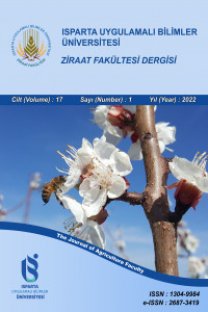Soğukta Muhafaza ve Kurutmanın Yağ Gülü Çiçeklerinin Uçucu Yağ İçeriği ve Bileşimine Etkileri
Yağ gülü, Rosa damascena Mill., gül yağı, muhafaza, kurutma
The Effects of Cold Storage and Drying on Essential Oil Content and Composition in Oil-Bearing Rose (Rosa damascena Mill.) Flowers
Oil-bearing rose, Rosa damascena Mill., rose oil, storage, drying,
___
- Antonelli, A., Fabbri, C., Giorgioni, M.E. and Bazzocchi, R. 1997. Characterisation of 24 old garden roses from their volatile compositions. J. Agric. Food Chem. 45, 4435.
- Arıdoğan, B.C, Baydar, H., Kaya, S., Demirci, M., Özbaşlar, D. and Mumcu, E. 2002. Antimicrobial activity and chemical composition of some essential oils. Archives of Pharmacal Research. 25, 860-864.
- Başer, K.H., Kürkçüoğlu, M. ve Konur, O.Z. 1990. Türk gül yağının üretimi ve özellikleri. Anadolu Üniversitesi, Tıbbi Bitkiler Araştırma Merkezi, Tıbbi ve Aromatik Bitkiler Bülteni, Gül Özel Sayısı 4, 13-15.
- Baydar, H. 2006. Oil-bearing rose (Rosa damascena Mill.) cultivation and rose oil industry in Turkey. Euro Cosmetics. 14, 13-17.
- Baydar, H. ve Göktürk Baydar, N. 2001. Yağ gülü (Rosa damascena Mill.)’nde verim ve kalite üzerine hasat dönemi, distilasyon için bekleme süresi ve distilasyon aşamalarının etkisi, IV. Tarla Bitkileri Kongresi, s. 117-122.
- Baydar, H. and Göktürk Baydar, N. 2005. The effects of harvest date, fermantation duration and tween 20 treatment on essential oil content and composition of industrial oil rose (Rosa damascena Mill.). Industrial Crops and Products. 21, 251-255.
- Baydar, H., Erbaş, S., Kineci, S. ve Kazaz, S. 2007. Yağ Gülü’nde (Rosa damascena Mill.) Damıtma Suyuna Katılan Tween-20’nin Taze ve Fermente Olmuş Çiçeklerin Gül Yağı Verimi ve Kalitesi Üzerine Etkisi. SDÜ Ziraat Fakültesi Dergisi 2(1), 15-20.
- Baydar, H., Schulz, H., Krüger, H., Erbaş, S and Kineci, S. 2008. Influences of fermentation time, hydro-distillation time and fractions on essential oil composition of Damask rose (Rosa damascena Mill.) Journal of Essential Oil Bearing Plants. Journal of Essential Oil Bearing Plants. 11 (3), 224-232.
- Buccellato, F. 1980. An anatomy of rose. Perfum. Flav. 5 (82), 29-32.
- Göktürk Baydar, N. and Baydar, H. 2005. Essential oil compositions of Turkish oil rose (Rosa damascena Mill.) products. 36th International Symposium on Essential Oils, 5-7 September 2005, Budapest-Hungary.
- Guterman, I., Shalit, M., Menda, N., Piestun, D., Yelin, M.D., Shalev, G., Bar, E., Davydov, O., Ovadis, M., Emanuel, M., Wang, J., Adam, Z., Pichersky, E., Lewinsohn, E., Zamir, D., Vainstein, A. and Weiss, D. 2002. Rose Scent: Genomics approach to discovering novel floral fragrance–related genes. The Plant Cell. 14, 2325–2338.
- Jabbarzadeh, Z., Khosh-Khui, M. 2005. Factors affecting tissue culture of Damask rose (Rosa damascena Mill.). Scientia Horticulturae. 105, 475-482.
- Kazaz, S. 1997. Hasat zamanı ve hasat sonrası bekleme süresinin yağ gülünde (Rosa damascena Mill.) yağ miktarı ve kalitesine etkileri üzerine bir araştırma. SDÜ Fen Bilimleri Enstitüsü, Bahçe Bitkileri Anabilim Dalı, Yüksek Lisans Tezi, Isparta.
- Kürkçüoğlu, M. and Başer, H.C. 2003. Studies on Turkish rose concrete, absolute and hydrosol. Chemistry of Natural Compounds. 39 (5), 457-464.
- Nikolov, N., Tsutsulova, A. and Nenov, N. 1977. Bulgarian rose oil and other essential oils. Medico Biologic Information 2, p.42-50.
- Nilsson, O. 1997. Rosa. In: Davis PH, editor. Flora of Turkey and The East Aegean Islands. Edinburgh: Edinburgh University Pres, 4, pp 106-128.
- Özkan, G., Sağdıç, O., Baydar, N.G. and Baydar, H. 2004. Antioxidant and antibacterial activities of Rosa damascena flower extracts. Food Science and Technology. 10 (4), 277-281
- Satikov, V., Balinova-Tsvetkova, A., Decheva, R. and Kalaidjiev, I.V. 1974. Rose flower storage conditions and their influence on the quantity and quality of rose oil. In: Proc. 6th Int. Congress Ess. Oils, San Francisco, USA.
- Senapati, S.K. and Rout, G.R. 2008. Study of culture conditions for improved micropropagation of hybrid rose. Hort. Sci. (Prague), 35(1), 27–34.
- Tucker, A.O. and Maciarello, M. 1988. Nomenclature and chemistry of Kazanlak Damask Rose and some potential alternatives from the horticultural trade of North America and Europe. In: Flavors and Fragrances: A World Perspective. Elsevier, Amsterdam, pp. 99-104.
- Weiss, E.A.1997. Essential oil crops. In: Rosaceae. CAB International. Wallingford, Oxon, UK, pp. 393–416.
- ISSN: 1304-9984
- Yayın Aralığı: Yılda 2 Sayı
- Başlangıç: 2006
- Yayıncı: Isparta Uygulamalı Bilimler Üniversitesi
İsmail Hakkı KALYONCU, Nilda ERSOY, Mehmet YILMAZ
LEVENT BAŞAYİĞİT, HÜSEYİN ŞENOL
İsmail Hakkı KALYONCU, NİLDA ERSOY, Mehmet YILMAZ
Said BİLGİNTURAN, Veysel AYHAN
Bazı Sert Çekirdekli Meyve Anaçlarının Doku Kültürü İle Çoğaltılması
Soğukta Muhafaza ve Kurutmanın Yağ Gülü Çiçeklerinin Uçucu Yağ İçeriği ve Bileşimine Etkileri
